Not Quite the Bahamas
 |
| Me, Bill, and John |
This voyage was to be the longest and furthest offshore I had gone, so a lot of preparatio\n was required. Days were spent making lists and tracking down the products I needed. Very little was available locally. More time went into trying to figure out transportation. I finally had to give up on a means of getting home until after I got there. (Travel agents are somewhat fussy about knowing exactly when you'll be returning, especially at a peak travel time. But, it was almost winter, and I didn't think I'd be in a rush to leave the Bahamas. Returning to shoveling snow was a detail that could wait.) Some of the items I purchased include harness and tether, type I life vest, near freezing capable sleeping bag, backpack, duffel bag, rigging knife, sailing gloves, C-light, and passport. There was very little room remaining in either the backpack or duffel bag after I squeezed in all the items I packed for both the temperature extremes, and a range of sailing conditions
The original plan called for me to meet up with the boat in Shelburne, NS for a November 11th departure directly to Bermuda and then on to the Bahamas after resting and reprovisioning, however, with things remaining to be done on the boat, and the workplace demands of the other two, Salt Heart was still in Charlottetown, PE at that date, so I met up with her there
It had been many years since I had traveled anywhere by bus, but it was a fairly pleasant ride over that included a total of 4 buses (Lewisporte Junction to Port aux Basque, North Sydney to Truro, Truro to Moncton, and Moncton to Charlottetown) and a ferry (Port aux Basque to North Sydney) over a day and a half, and across 3 provinces. Bill was waiting at the bus terminal when I arrived at about 2340 on Friday, November 10th, 2000. He drove me back to the boat where I got a brief tour before settling in for the night. John and his wife, Stephanie, arrived Saturday morning, and I met them for the first time. The big job for the day was to install a masthead tri-light. After designing and shaping a metal bracket, someone had to be hoisted up the mast to see how to go about installing it. That task was assigned to the boat owner, Bill, even though he was the heaviest of the 3 of us.
We attached the main halyard to the bosun's chair, and the spinnaker halyard to his harness - just in case. We rerouted the main halyard to a larger winch, and with much effort, had the skipper at the top of his boat for the first time. After marking the location of the required holes, he came back down while we fastened the light's base to the bracket, and got everything in place to make the mast attachment. The honor of the second trip up the mast went to the lightest person, me. It was cold, windy and eventually dark, but I managed to drill the two holes, tap them, bolt on the bracket and wire up the boat's new main navigation light. The hot supper at a local restaurant was most welcome after that experience. The overflowing black water holding tank was not.
Even though Bill had been living on the boat for the summer, he rarely used the head, and lost track of the last time it was emptied. With the three of us now making use of the facilities, it was soon topped up, and then some. The excess went into the bilge. We pumped it all out, and cleaned it up as best we could. It was decided not to go more than 2 or 3 days without using the macerator to empty the tank. John slept aboard with us that night, and the 3 of us began settling into life together on the boat.
Sunday's tasks included relocating and recabling the windvane control knob, filling the fuel tank, attaching the bow anchor, rerigging the SW antenna (we had used that halyard to supply parts and tools for the light installation.), and generally making the final preparations to our new home. The boat itself is a 1984 Bayfield 32C bearing hull #50. Bill had invested quite a lot in an already sound boat to make the trip safer and more comfortable. She had radar, windvane, autohelm, and amateur radio communication equipment on top of all the standard electronics. Canned food enough for the entire voyage was stashed in various locations. Fuel containers and a deflated Zodiac were lashed to the deck. Salt Heart certainly looked like a boat ready to go somewhere, as she sat a couple inches lower in the water.
 |
| The view below |
On Monday morning, after saying goodbye to those who came by the marina to bid us farewell, we cast off the lines and headed out the harbour. Our intention was to go just as far as Wood Islands to get everyone used to the boat, and each other. As we neared our destination, things were going so well that we decided to carry on to the Canso Lock, and find a place just beyond that to dock. While it seemed like a good decision at the time, it was not long before the wind and seas began to pick up. 2/3 of the crew got a bit sea sick (names withheld!), the boat took some hard bangs, things were thrown about the cabin, the gimbaled stove fell apart, we lost house batteries and had to run the navigation lights using the starting battery, part of a repaired trailboard broke off, the windvane had to be retired, and for a few hours, the passage was generally miserable. Not quite the leisurely sail we had expected.
About 0400 we arrived at the Canso Lock. I'd driven over the bridge and causway several times, but this was my first time in the lock itself, or any lock for that matter. It was interesting watching the large steel structure swing out of our way. Once through, we passed two fishing boats heading north - the wrong direction as far as we were concerned. Bill went below to see where we were going to put in for a few hours rest and recovery, while I played with the engine controls and practiced maneuvering Salt Heart under power.
Port Hawkesbury was the closest town which would likely have available most anything we required. We found our way to an empty set of floating docks next to a large wharf. All the local boats had been hauled out for the winter, and we were the only vessel there - stranded behind a locked gate. It was good enough for the night, or morning as it now was. It was close to 0600 by the time we turned in, and almost lunchtime before we were up again.
After putting the wave tossed items away, we decided to move Salt Heart over to the wharf where the shore could be accessed easier. Later in the day we moved her again, this time to the other side where we would get some better protection from the expected winds. John wisely saw that we were always pointing into any winds. Most of the day was spent rewiring the boat so that we did not run into problems like we had the previous evening. My suggestions were accepted as part of the plan, and Bill and John went on an excursion to town to purchase the parts we required. I stayed behind to continue the cleanup operations. By dark we had everything up and running, better than it was before.
The forecasted strong winds arrived on Wednesday, and we decided it would be best to stay put for at least a day. It is just as well we did since the fresh water electric pressure pump gave out, and the used backup also failed to operate. Bill had a new pump stowed away that got the water flowing again, but now we were without a backup. A suitable replacement was found in Port Hawkesbury and delivered by someone at the store. We had to remind Bill how warm he was going to be once we got to the Bahamas to keep him motivated as he worked outside in the cold, wind and rain.
While Bill was working on getting water into the boat, I was forward trying to get water out of the boat. The head sink was not draining. I traced the problem to a dip in the hose. I rigged up a bracket to hold it closer to the underside of the v-berth, and we never had that problem again. We needed both sinks working with 3 people aboard.
At 1530 we checked in with Herb Hilgenberg (VE3LML, Southbound II), the expert marine forecaster from Burlington, ON, on 12.359MHz, USB. He advised us to stay where we were for a couple days since the winds were going to continue to be high. The crew of the tug, Epinette II, who were tied up next to us suggested the same thing. They were not planning to leave until Saturday. They were also kind enough to allow us to plug into their electrical. The wharf's power connection did not mate with theirs, so they would have to run their generator anyway. We only had a small heater and a light bulb to power. The heat was certainly welcome. It was, after all, the middle of November.
Thursday marked a week since I had left home. I had not packed for so many days of cold weather, since I was only supposed to have a couple days of it. Shorts remained buried deep in the duffel bag, while t-shirts became another layer under the sweaters. Some clothes had been worn 4 or more days since last washing. I needed to get a new laundry bag to replace the one I borrowed from Bill. In addition, my big flashlight had suffered massive internal injuries on the passage from Charlottetown, so I was in need of another one. Bill and John had some shopping to do as well, so we called a cab and headed into town to clean out Canadian Tire and Sobeys. Bill got a voltmeter and an ammeter to put on the house batteries to be able to keep an eye on their health. The new wiring system had not, as yet, been given much testing time, and we were planning to head offshore.
While Bill drilled more holes in the boat and installed the gauges, John and I devised a way to mount the GPS to the binnacle with parts we picked up during the shopping spree, and things we found on Salt Heart. A board across the handrail with 2 u-bolts served to adequately secure the GPS stand where it could be used by the helm, yet not block the compass, or take too much room away from hands on the rail. I made a temporary connection into the compass light's power. Bill fixed a minor electrical problem with the propane solenoid, enabling John to cook up a wonderful steak dinner on the ungimbled 2 burner stove, even though the gimbaled unit was now functional again.
Before bed, we had to swing the boat around again to face into the night's wind. I wasn't able to sleep feeling there was something wrong with the boat, so I stuck my head out the companionway for a look. The bowsprit was well over the concrete wharf, and the tide was high. The dock lines would need adjusting before a lower tide level caused the boat serious damage. While I was out working on this Bill came up to see what was happening and gave me a hand. It didn't take long to have her lying parallel again. I slept through the 0400 check and fine tuning Bill did.
I always keep a road map with my navigation gear since many of the charts I use don't have much, if any, detail on the communities. It also gives you a good overview of an area. The old map I had stuffed into my backpack was tattered, torn and missing a section, but it did show that the Town of Canso would be a good place to head for. My thought was better many small steps than waiting for one or two big steps. Bill and John were of the same mind, so at 1027 we finally left Port Hawkesbury behind.
I had the wheel most of the passage and enjoyed a great sail under double-reefed main and staysail in winds that gusted up to 30 knots. We had been motoring into the wind at first, but it was too much strain on the engine. It overheated at nearly the halfway point, so being a sailboat, we shut it off and kept going, at even greater speed. 6+ knots was not uncommon even though we were closehauled.
Along the way we passed close by a seal just bobbing in the bay. We also passed very close to a fairway buoy. The skipper wanted to be near enough to read the number, but I guess he didn't want to be close enough to reach out and touch it. I hope it proved to him I could handle the boat, and steer a good course. The buoy was our waypoint after all.
The tug had left a couple hours prior to us, but we passed them heading back into Port Hawkesbury before we were very far out. Apparently, we rode the wind and seas much better than they did, and thus arrived safely at Canso 1615, while they spent another day back where they had been.
Entering the harbour was not as difficult as it initially looked on the charts. There were rocks and breakers, but the channel was well marked. There was a floating section, not mentioned in the Sailing Directions, attached to the public wharf where power was available, and so we docked there. We hadn't even finished tying up when a woman from the port authority came looking for a fairly reasonable $0.60 per foot. I think we would have paid more to keep the heater running.
Problems this leg were limited to a blown fuse for the water pump, and lose connection on the ham radio which caused us to miss our check-in time with Herb. We could hear him talking to other boats on the water not too far from us, so we managed to get some information which was of use to us as well.
The sun was shining for the first time in weeks when we awoke, and that inspired us to get busy with odds and ends still left to be done on the boat. I rewired the power socket for the GPS more permenently. A test showed that the twisted wire did not generate any noticeable deviation. I then trimmed the edges of the board so that it would be less likely to be in the way, and that also improved the looks. Tape was put under the u-bolts, and the ends past the nuts cut off. We were pleased with the result.
John and I then turned our attention to the rigging. I know I should have checked before we got underway at Charlottetown, but here we were at Canso without split rings, or even cotter pins, in most of the turnbuckles. Looking up the mast track I could see it was more 'S' than 'I'. We adjusted, checked tensions, stood back and looked, readjusted, and eventually we had what we agreed was a well-tuned mast. The town was lacking in supplies, so we pinned, ringed, or wired as we could until the stay turnbuckles were all locked off.
By that time, Bill had completed installing the lights on the new gauges, rewired the ham radio power, sent an email, returned from a provisioning trip ashore, and had supper underway. The forecast looked good for at least an 18 hour window. We'd check again in the morning to verify it, and then get out as fast as we could. Bill used his electronic charts to plot a route out of the rocky Canso harbour, and I programmed the GPS with the waypoints. From that point on I was more involved in the navigation and made regular GFIX's on the charts.
We got up a little earlier than we had been doing to eat and get moving. We walked the boat down to the wharf and filled the tanks with suspicious looking brown water we were told was good. By 0930 we were heading out the harbour. Bill took us out so far, and then I started my watch. Seas were still 2-3m, but winds were probably under 10 knots. Our friends in the tug passed us by shortly before we made the turn onto the long track southwest towards Shelburne. Since we were motorsailing anyway, we decided to hook up the autohelm, so I had little to do during my 2000 to midnight watch. It was the only watch I had were one of the self-steering machines was engaged for the entire shift. I was not used to them. Being on watch, to me, had always meant being at the wheel. This was a nice change.
I didn't sleep well because of the cold, so I got up around 0700 and fired up the new propane heater John and I suggested Bill pick up at Port Hawkesbury. It helped a lot even though the wind was now behind us and blowing down the companionway. The two kerosene lanterns were unable to produce enough heat on their own. The third one was leaking and was abandoned at Canso.
With all the hatches and port lights constantly closed to keep the scant heat in, condensation was everywhere. While conditions were as good as could be expected under the circumstances, they were far from ideal. Water dripped on us from the hatches, and everything closed off between the walls and the hull was damp. We had to open the sliders while in port to let some air circulate back there. You could feel the cold draft flow over you while laying in the berth.
We did not see very many other boats during the entire trip, but Monday morning a navy ship passed in front of us, and an accompanying helicopter flew close overhead to check us out. (My camera was never close when I needed it.) Bill and I were surprised by how small a target the ship was on the radar. Later that night, a fishing boat circling around in the dark, as another boat headed offshore, and red lights shone from the land confused us for a while until we were able to sort out what was what.
My evening watch was a hard one with the following seas and winds to contend with, no autopilot, and no one on deck to talk to. We had been making good time for most of the day though, with 6 and 7 knots SOG on the GPS being maintained. We were actually running ahead of schedule, so that should have been a hint of things to come. I was glad when my time was up and looked forward to crawling into my berth. First, however, Bill wanted me to dig out the Shelburne harbour charts, so I fired up the kerosene lamps and started going through the rolls. I eventually found them and determined a heading to steer once we arrived at the only waypoint in the GPS. We were using the nav aids feature of the Magellan 320 to give us reference to the land we could not see at some 25 miles to starboard. I was very tired by the time I finally got under some covers and my head on a pillow.
Around 0200 I was tossed out of my bed. Apparently it was a little rougher out, but being sleepy I wasn't overly concerned, so went about getting myself settled in again. Then I heard Bill call out. I stuck my head up the companionway to see what the problem was and saw that it had become much more nasty than it had seemed down below. I informed John who was already starting to get up, and got myself into my floater suit. We tethered ourselves to the cockpit pad eyes, and discussed how we were going to handle the gale force winds which were directly on our course line. The decision was to shorten sail to just a double reefed main, and then go further offshore to ride it out until daylight.
It was up to me to go forward and lash down the staysail. Not an easy task in the winds and waves, but I managed to secure the sail to the deck and make my way back to the cockpit without being swept overboard. I was wet through, freezing cold and exhausted, so after determing there was little else I could do above decks, I had to go below to get some rest. I used the leecloth on the settee for the first and only time. It held me securely in place, and allowed me to get about 4 hours sleep while the other two surfed down 6-8m waves.
By the time I was back on deck we were once again making progress towards Shelburne. Shortly after 0900 a group of some 15 or 20 porpoises put on a show for us as they passed across the bow from starboard to port. Swells were still 2.5 to 4m, but winds had dropped considerably. We arrived at the waypoint for the entrance to Shelburne harbour about 1600, just as it was starting to get dark. It took over 2 hours more before we found a wharf to tie to and got settled in. Fortunately, there was power on the wharf for the heater. We ate a quick supper and started getting ready for bed. I sat down for a second to rest my eyes and was out. I woke up a couple hours later and got into my sleeping bag - clothes and all.
Wednesday morning there was frost on the boat, and a light skim of ice covering the salt water around the boat, but the sun was shining. Bill and John hung a few things like floater suits and sleeping bags around the deck to air out and dry. Bill then went for a walk to see what services were available to us. I got a good wash in the head, and then sorted my laundry. We spent most of the day washing and drying our clothes at Murphy's. We picked up some groceries and other items, like warm gloves. Keeping warm, especially the hands, was a major problem for all of us. Various combinations and layers were experimented with. We were getting close to finding the ideal solution. Getting across the Gulf Stream quickly was the best one. Upon return to the boat John prepared another marvelous meal. Being tucked down behind a high wharf and even higher boats, we were unable to make contact with Herb, so an important forecast was missed with us planning to head for Bermuda the next day.
There were still lots of little jobs to do on Thursday before we could go. An inspection of the boat showed that the top two sliders were broken at the head of the main sail. Bill got two off the old main, and John and I made the repairs. He and I were not too happy with the way the lines were arranged on the boom, so we reconfigured the reefing lines, outhaul and topping lift. I secured the fuel cans. We then headed over to another wharf to flush and fill the water tanks and containers. A sloppy deck filler cap that had allowed salt water to get in the fresh water tank was sealed shut. (No wonder my tea tasted so bad!) At shortly past 1530 we were on our way to Bermuda.
I took the helm as soon as we cleared the dock when Bill went below to call Southbound II. Out clear of the wharf, and the other boats, he was able to get a signal though. John started his watch at 1600. I stayed with him to finish stowing the fenders and dock lines, then helped raise the main. That is when we discovered a problem with the Spinlock. It wouldn't hold the lines. I had to leave the main in the self-tailer of the winch, and then tie off the reefing line on top of it. I fooled with it a bit later on, and managed to get it to catch, but that was just the first problem. Next, was the masthead tri-light. It wouldn't work when we switched it on. Bill got up and fiddled around behind the fuse panel until he got it operating again, then went back to try and get a nap.
With everything apparently under control, I went below to have a bite to eat and a short rest before putting on my floater suit and gear, to help out while I awaited my watch. This is when the most serious incident took place. We were on a run, heading out the harbour. Winds were light so I didn't bother to rig the gybe preventer I had devised. John didn't like it anyway since it was difficult to operate when single-handed. Next thing I knew there was a great noise from the cockpit. Bill stuck his head up to see what the problem was and was told that we had gybed, but the traveler stop didn't stop the car, and was lost overboard. (My theory: The stop was probably only resting on top of a screw head, and not secure in a hole. The plastic ends of the traveler must have been too cold and brittle to withstand the sudden force. When the sail came across, there was nothing there capable of holding it.) John was holding onto the loose main sheet after having headed the boat into the wind, back towards Shelburne. I went up to see what I could do.
The sheet was too tangled to get working with the boom bouncing about, so I put the car back on the track and tied it off against the remaining stop. Then I dropped the main and secured it to the boom. It was at this time I learned that the lost stop was a new one Bill had to get shipped in from Ronstan in Australia. It could take weeks to obtain another one. There was a storm on the way we were trying to keep ahead of when we set out, so even if we could get the part faster, we'd lost our weather window, and would probably have to wait another 4 or 5 days for the next one. It was quiet on the way back as all hands considered the situation.
Once we were back in our old berth at the government wharf, Bill announced that this was the end of it. He would haul the boat out of the water in Shelburne and try it again next fall. We were all disappointed, but agreed that this was probably the best decision. Too much had happened, it was too cold, weather windows were small and rare, and while the skipper had all winter, time was running out for the two crew. It was 2 weeks now since I had left home.
We got up on Friday, and started getting the boat, and ourselves, packed up. Bill went with a local resident, Rick, to see if Salt Heart could be stored locally, and if so, when they could lift her out. I was just shaking the frost off the sails, and getting ready to raise them to dry, when Bill returned saying we had to go right away. The tide was dropping, and she had to come out before it got too low. I returned to the marina facility with Rick to help catch the lines. With all the stored boats and parked vehicles, the yard workers had some trouble getting the travel lift over to the pen, and the boat touched bottom twice before it was finally hoisted from the water. All of our freshly added water was now part of Shelburne harbour.
While the yard workers were busy blocking up the boat, Bill went in search of a rental vehicle that could be used to carry all his belongings, John's stuff, and the boat gear back to Charlottetown. John and I made ourselves busy packing things. I barely managed to get all my stuff back into the backpack and duffel bag they came over in. Most items were cleared off the deck when Bill returned with news that a truck would be ready at 1700. He too engaged in some packing, and also made another unsuccessful attempt at contacting Herb to let hem know we could be taken off his list. When the time came to go get the U-Haul, Bill walked up to get it. Upon his return we threw what was ready in the back, and went off in search of a motel room.
After checking in and depositing our belongings, we went out to a local restaurant for our last meal together. We talked about the trip, and what we were going to be doing when we returned home. We chatted about things we never had time for while on the boat. The food was excellent, as was the company. The three of us had lived together, in very close quarters and imperfect conditions, for two weeks. It was sad to be abandoning our effort, and breaking up the team. I could barely remember what life was like in the real world.
Back at the motel I trimmed my now larger than normal beard, showered, and generally prepared myself to be back in civilization. Saturday morning Bill drove me up to the gas station where I'd catch the first of 3 buses and a ferry to get me home. He and John still had several hours of work to do, and a long drive back to Charlottetown. We didn't quite get to the Bahamas, but we did have some good sailing, good times, and learned many things. I also got to make two new friends. I hope I'm available next fall should Salt Heart once again attempt the voyage south.
Top Ten Lessons Learned:
10. An unsecured object can become a dangerous projectile when it gets rough, or at least make a mess of the cabin.
9. Things are going to happen, and you just have to deal with them as best you can at the time. Survive now, improve later.
8. Keeping warm and dry can be a very difficult thing to do, even with high tech materials. You can also have too many layers.
7. Your best survival tool is a good sense of humour, but you should be able to think fast on your feet too.
6. You can never be too prepared, but you'll never have everything you'll need. Make sure you have all the basics covered.
5. A good meal does wonders for moral. Food is important. Stick to meal schedules.
4. Don't leave port with serious problems, even if you think you would handle it ok should the problem happen underway.
3. Surround yourself with good, capable people who know what they are doing, and that can offer suggestions, but remember that the person in charge has the final word.
2. Know when to quit. As Bill said, "He who fights and runs away, lives to fight another day."
1. Keeping warm and dry in November on the North Atlantic is tough!
- Peter Haliburton © 2000
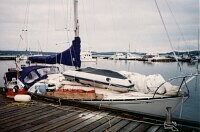
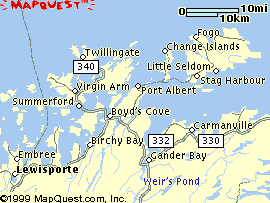 This
didn't leave me much time to get ready. My clothes were still in the
laundry from our visit to St. John's. I had to get to the bank and the
stores, organize, and pack. It was a rush job, but we managed to pull
away from the wharf at the Lewisporte marina around noon on Thursday. I
was finally sailing.
This
didn't leave me much time to get ready. My clothes were still in the
laundry from our visit to St. John's. I had to get to the bank and the
stores, organize, and pack. It was a rush job, but we managed to pull
away from the wharf at the Lewisporte marina around noon on Thursday. I
was finally sailing.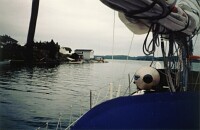
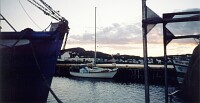
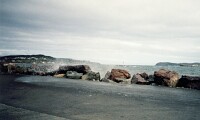
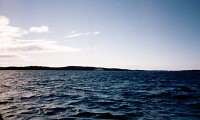
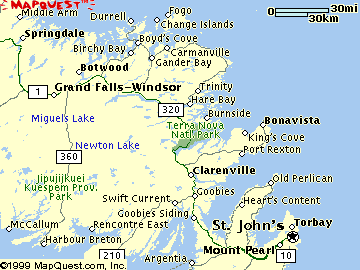 By
dark, the closest community was Musgrave Harbour. The sailing
directions indicated we could find enough water for the boat's draft at
the fish plant wharf, so this is where we decided to put in. Following
the lights of the navigation buoys we made for the harbour. Seas were
still around 2-3m, so we could see waves breaking too close for comfort.
Once at the edge of the breakwall a tight starboard turn was required,
but in the darkness doubt can creep in. We took our time, rechecked our
path through the flashing reds and greens, and pressed on with fingers
crossed. Arriving at the wharf we found no good place to tie up among
all the fishing boats, so after checking with a local, we took the bay
for the marine travel lift. With lines and fenders on both sides, we had
a much more restful night than the one Friday at Twillingate.
By
dark, the closest community was Musgrave Harbour. The sailing
directions indicated we could find enough water for the boat's draft at
the fish plant wharf, so this is where we decided to put in. Following
the lights of the navigation buoys we made for the harbour. Seas were
still around 2-3m, so we could see waves breaking too close for comfort.
Once at the edge of the breakwall a tight starboard turn was required,
but in the darkness doubt can creep in. We took our time, rechecked our
path through the flashing reds and greens, and pressed on with fingers
crossed. Arriving at the wharf we found no good place to tie up among
all the fishing boats, so after checking with a local, we took the bay
for the marine travel lift. With lines and fenders on both sides, we had
a much more restful night than the one Friday at Twillingate.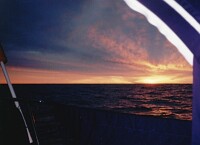
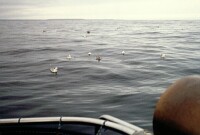
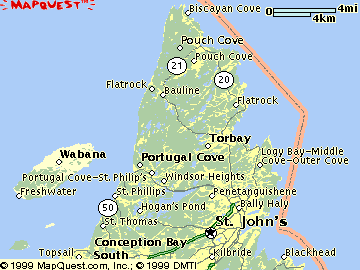 It
had been the middle of that afternoon before the arrangements were
made, and after a few hours of driving she was at the waterfront waiting
for us, while we had traveled for five days and not yet tied up. She
had contacted the harbour master to see if he had heard from us, so it
was him calling to find out where we were. With some help from him we
found a spot to dock right in the middle of the waterfront, beside a
tour boat. A good place for Peter to be able to get around, see some
sights, and take care of the few things he had to do.
It
had been the middle of that afternoon before the arrangements were
made, and after a few hours of driving she was at the waterfront waiting
for us, while we had traveled for five days and not yet tied up. She
had contacted the harbour master to see if he had heard from us, so it
was him calling to find out where we were. With some help from him we
found a spot to dock right in the middle of the waterfront, beside a
tour boat. A good place for Peter to be able to get around, see some
sights, and take care of the few things he had to do.